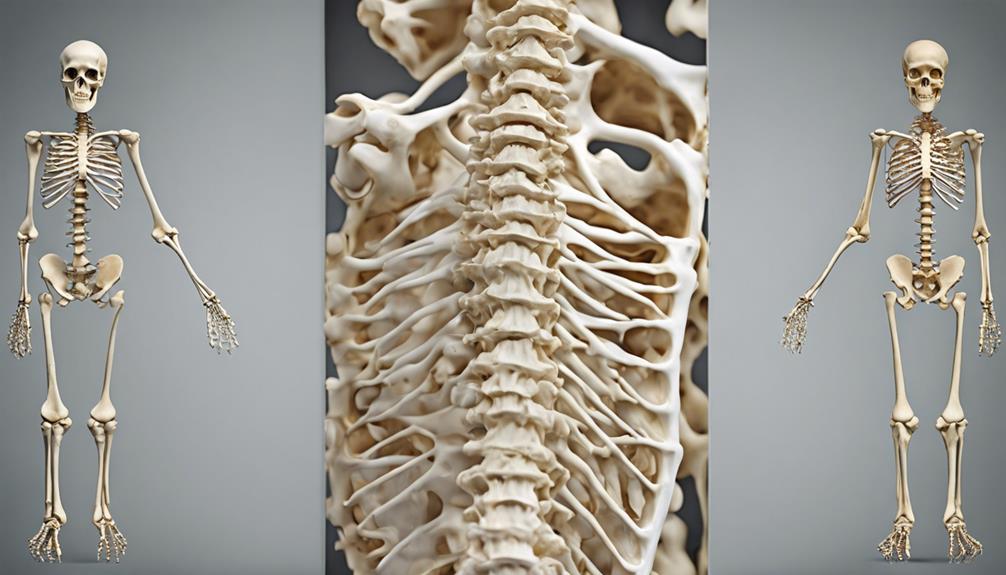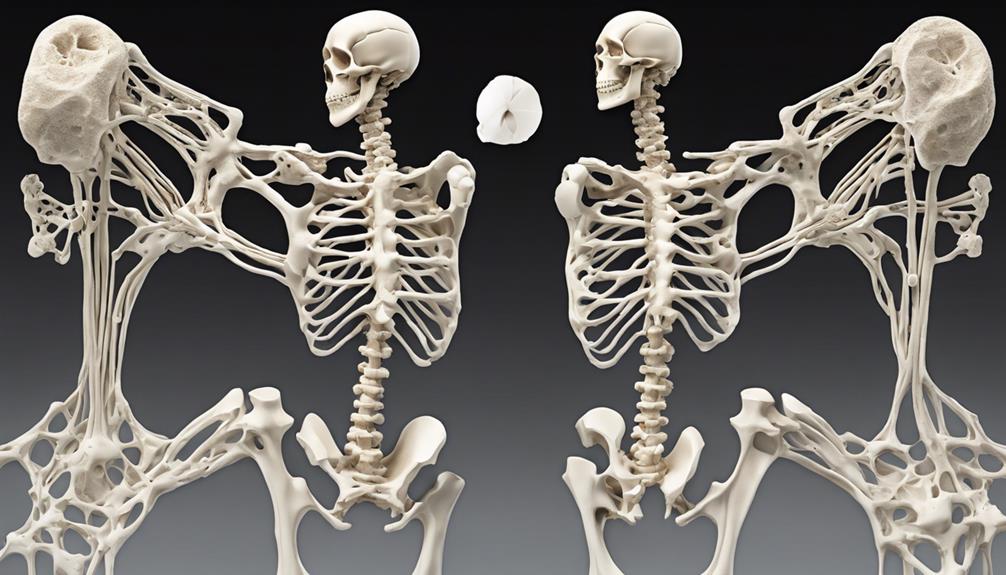Did you realize that about 54 million Americans aged 50 and older have osteoporosis or low bone density? This condition significantly affects the well-being and independence of individuals.
When it comes to managing osteoporosis, infusions present a compelling treatment avenue that offers unique advantages. Beyond just addressing bone density concerns, these infusions have shown promising results in enhancing overall bone health.
Explore further to uncover how this treatment option could potentially revolutionize osteoporosis management.
Key Takeaways
- Annual zoledronic acid infusion for osteoporosis convenience and adherence benefits.
- Direct bloodstream delivery reduces side effects and enhances treatment adherence.
- Monitoring renal function post-infusion crucial for managing potential mild side effects.
- Long-lasting effects, improved bone density, and reduced fracture risk with infusions.
The Benefits of Infusions for Osteoporosis
Highlighting the efficacy of osteoporosis infusions, such as zoledronic acid, in comparison to oral bisphosphonates underscores their superior convenience and adherence benefits. The annual administration schedule of zoledronic acid stands out as a compelling advantage in osteoporosis treatment. By requiring only one infusion per year, individuals can more easily adhere to their treatment plans, ultimately enhancing their bone health outcomes.
Additionally, the avoidance of common gastrointestinal side effects associated with oral bisphosphonates is a significant benefit of infusions like zoledronic acid. This reduction in side effects plays a crucial role in improving adherence rates, as individuals are less likely to discontinue treatment due to intolerable reactions. Studies have indicated that infusions, by offering a more manageable treatment experience, may lead to better overall adherence compared to oral medications.
The preference for less frequent treatments, such as infusions, among osteoporosis patients further supports the idea that these options can positively impact treatment compliance and effectiveness.
How Infusions Work for Osteoporosis

Bisphosphonate infusions, such as zoledronic acid, function by inhibiting bone resorption, strengthening bones, and reducing fracture risk in individuals with osteoporosis.
- Zoledronic acid is administered once a year via intravenous infusion for osteoporosis treatment, providing a convenient and effective option for many individuals.
- Infusions deliver medication directly into the bloodstream for quick action, allowing for better adherence to treatment plans compared to oral medications.
- Infusions like zoledronic acid have been shown to have better adherence rates and less treatment discontinuation due to side effects than oral bisphosphonates.
This method bypasses the gastrointestinal system, where oral medications can cause irritation or discomfort, improving the patient experience.
Potential Side Effects of Infusions
We'll now address some potential side effects of osteoporosis infusions. These infusions may lead to flu-like symptoms in about 30% of patients after the first dose, which usually diminish over subsequent treatments.
Additionally, common side effects like muscle pain, joint pain, and headaches may manifest within 1 to 3 days post-infusion.
Infusion Risks
Experiencing flu-like symptoms, muscle pain, joint pain, and headaches within 1 to 3 days post-administration are potential side effects associated with osteoporosis infusions. When considering infusion risks, it's essential to be aware of the following:
- Side effects are often mild and self-limiting.
- Acetaminophen or NSAIDs can help manage common infusion-related symptoms.
- Bisphosphonate infusions may pose a slightly increased risk of renal injury compared to oral forms.
Being vigilant about these potential risks and promptly addressing any concerning symptoms can contribute to a safer infusion experience for individuals undergoing osteoporosis treatment.
Common Side Effects
After discussing the potential risks associated with osteoporosis infusions, it's crucial to understand the common side effects that individuals may experience post-administration. Approximately 30% of patients may encounter flu-like symptoms after the initial intravenous zoledronic acid infusion, with a decreasing incidence in subsequent treatments. Muscle pain, joint pain, and headaches are prevalent side effects typically manifesting within 1 to 3 days following the infusion.
These symptoms are generally mild and self-limiting, often resolving without specific intervention. Acetaminophen or NSAIDs can be used to manage infusion-related discomfort effectively. It's important to note that bisphosphonate infusions, including zoledronic acid, have a slightly elevated risk of renal injury compared to oral forms, necessitating vigilance in monitoring kidney function post-infusion.
Monitoring Infusion Therapy Progress
Throughout the course of infusion therapy for osteoporosis, the progress is meticulously monitored through a combination of DEXA scans, blood tests, and clinical assessments. DEXA scans are crucial for tracking bone density changes, providing quantitative data on the effectiveness of the treatment.
Blood tests play a vital role in assessing various parameters such as calcium levels and renal function, ensuring the therapy isn't adversely affecting the patient's overall health.
Clinical assessments are essential for evaluating the reduction in fracture risk and overall improvement in bone health due to the infusions.
- Regular DEXA scans to monitor bone density changes.
- Blood tests for assessing calcium levels and renal function.
- Clinical assessments to evaluate fracture risk reduction and bone health improvement.
Comparing Infusions to Other Treatments

When comparing infusions to other treatments for osteoporosis, it's essential to consider the efficacy of infusions in delivering medication directly into the bloodstream.
Additionally, a crucial point of comparison lies in the differences in side effects between infusion therapies and oral medications.
Evaluating the long-term benefits of infusions versus alternative treatments is also a key aspect to explore in understanding the optimal management of osteoporosis.
Efficacy of Infusions
Comparing osteoporosis infusions to other treatments reveals their superior efficacy in increasing bone mass and reducing fracture risk in men and postmenopausal women. When considering infusion therapy such as zoledronic acid and ibandronate:
- Infusions offer a more convenient and less frequent treatment option, potentially enhancing adherence rates.
- Zoledronic acid infusions have shown higher adherence rates and lower discontinuation due to side effects compared to oral bisphosphonates.
- Ibandronate infusions every 3 months for postmenopausal women effectively prevent bone resorption and reduce fracture risk associated with osteoporosis.
These findings underscore the significant benefits of infusion therapy in managing osteoporosis, particularly in populations such as postmenopausal women, where treatment adherence and efficacy are crucial.
Side Effects Comparison
Infusion therapy for osteoporosis, such as zoledronic acid and ibandronate, presents distinct advantages in managing the condition by reducing the occurrence of common gastrointestinal side effects associated with oral medications. While mild side effects like muscle pain, joint pain, and headaches post-infusion may occur, they're typically manageable.
Compared to oral medications, infusion therapy enhances treatment adherence by eliminating gastrointestinal issues that often lead to discontinuation. Approximately 30% of patients may experience flu-like symptoms after the initial infusion, which tend to diminish over subsequent treatments.
It's important to note that bisphosphonate infusions carry a slightly higher risk of renal injury compared to oral forms, necessitating close monitoring by healthcare providers. Despite this, infusion therapy remains a convenient and effective option for managing osteoporosis, offering benefits such as improved treatment adherence and lower chances of discontinuation due to side effects.
Long-Term Benefits
What long-term benefits do osteoporosis infusions, such as zoledronic acid, offer compared to other treatment options?
- Improved bone density and reduced fracture risk
- Enhanced adherence to treatment plans with less frequent dosing schedules
- Higher patient satisfaction rates and lower discontinuation rates due to side effects
These benefits highlight the advantages of osteoporosis infusions over oral medications.
Infusion therapy, particularly with zoledronic acid, not only provides a quick onset of action and long-lasting effects but also eliminates gastrointestinal side effects commonly associated with oral bisphosphonates. The convenience of infusions and the potential for improved outcomes make them a favorable choice for individuals seeking effective and well-tolerated long-term osteoporosis treatment options.
Nonmedical Approaches for Osteoporosis

Implementing nonmedical approaches is crucial in managing osteoporosis and reducing the risk of fractures. To assess bone health, individuals may undergo a bone density scan to evaluate the risk of fractures and determine the appropriate course of action. Consuming adequate amounts of calcium and vitamin D through diet or supplements is essential for maintaining bone strength and density, thus aiding in osteoporosis prevention.
Engaging in weight-bearing exercises, such as walking or resistance training, helps improve bone density and reduce the likelihood of fractures in individuals with osteoporosis. Fall prevention strategies, including removing hazards in the living environment and practicing balance exercises, can significantly lower the chances of fractures in those at risk.
Lifestyle modifications like moderating alcohol consumption, decreasing caffeine intake, and quitting smoking play a crucial role in enhancing bone health and reducing fracture risk. By incorporating these nonmedical interventions alongside medical treatments, individuals can adopt a comprehensive approach to managing osteoporosis effectively.
Infusion Therapy Review and Recommendations

Utilizing infusion therapy for osteoporosis involves the direct administration of medications like zoledronic acid or ibandronate into the bloodstream through a needle or catheter. Bisphosphonates used in infusion therapy inhibit bone resorption by osteoclasts, aiding in improving bone density and strength in osteoporosis patients. Zoledronic acid is typically administered as a yearly infusion, while ibandronate may be recommended every 3 months for postmenopausal women with osteoporosis.
Potential side effects of bisphosphonate infusion therapy may include bone, joint, or muscle pain, with rare occurrences of hypocalcemia and flu-like symptoms. Alternative osteoporosis treatment options like denosumab, which is administered via subcutaneous injection, provide additional choices for patients intolerant to bisphosphonates.
When considering infusion therapy for osteoporosis, it's essential to weigh the benefits of bisphosphonates such as zoledronic acid and ibandronate against the potential side effects. Understanding the different administration schedules and alternative treatments like denosumab can help tailor the therapy to individual patient needs effectively.
Frequently Asked Questions
How Effective Are Infusions for Osteoporosis?
Infusions for osteoporosis are highly effective in increasing bone mass and reducing fracture risk. They've been shown to prevent new fractures, offering comprehensive protection against osteoporotic fractures.
Studies indicate superior adherence rates with infusion therapy compared to oral medications, ensuring consistent treatment. Infusions provide a convenient and efficient way to manage osteoporosis, eliminating common side effects and promoting better compliance for long-term bone health.
What Are the Side Effects of the Yearly Infusion for Osteoporosis?
Sure thing!
When discussing the side effects of yearly infusions for osteoporosis, it's crucial to note that common reactions can include flu-like symptoms such as fever, chills, and fatigue. Muscle pain, joint pain, and headaches may arise within 1 to 3 days post-infusion. These effects are typically mild and transient, often resolving without intervention. Acetaminophen or NSAIDs can help manage any discomfort.
Bisphosphonate infusions, like zoledronic acid, carry a slightly increased risk of renal injury.
How Long Does an Osteoporosis Infusion Last?
Osteoporosis infusions vary in duration based on the medication used. Infusions can last from 15 minutes to a few hours, depending on the specific drug.
Zoledronic acid (Reclast) is typically given yearly and takes about 15 minutes. Ibandronate (Boniva) is usually administered every 3 months, lasting 15 to 30 minutes. Pamidronate, not FDA approved for osteoporosis, has a duration that varies.
Infusions are tailored to individual needs and are often short and well-tolerated.
What Infusions Increase Bone Density?
We're diving into the world of infusions that boost bone density. Various infusions like Zoledronic acid (Reclast) and Ibandronate (Boniva) have shown efficacy in this realm.
These infusions are administered at specific intervals with varying dosages to enhance bone density in individuals with osteoporosis or related conditions.
The journey to stronger bones through infusions is a promising path for those seeking to improve bone health.
Conclusion
In conclusion, infusions for osteoporosis offer a revolutionary solution that drastically improves treatment outcomes. With their ability to enhance bone mass, reduce fracture risk, and minimize side effects, infusion therapy stands as the gold standard for managing this condition.
Embracing this cutting-edge approach not only ensures better adherence rates but also sets a new benchmark for effective osteoporosis treatment.









